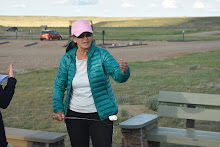We have been amazed at the interest in our life here off grid near Bancroft, Ontario, Canada, since appearing on "Exploring Alternatives". Mat and Dadielle produce an excellent 17 minute video of our lifestyle and why we chose to live off grid. Many of you have questions and so I decided to try and answer them here.
1) We are "OFF GRID" in the sense that we are not connected to the electrical power grid here in Ontario. We made this choice after receiving a quote of $45 - $75,000 to bring the power line to our property. We would then have to hire a private contractor to bring the line to the house in accordance to code; more $$$. WE decided to install a solar system which cost us $32,000 compltely installed and inspected. That decision saved us at least $15,000 I suspect a lot more.
2) WHY 2,5000 sq.ft. We want to live here until we die and felt that a one floor structure best suited that decision. WE have no basement, which would have been used to house the mechanical room, wood storage, cold storage for food, furnace, work shop, etc. Basement space isn't considered in the square footage of a house here in Ontario and that would have given us a much smaller footprint.
We have extra bedrooms for family and friends when they visit as most have a 4-5 hour drive to get here. When they come they stay and we are delighted.
3) SIZE OF PROPERTY. We have 33 acres, most is covered in bush with two small beaver ponds and a small stream on the property. We have trails through the property for snowshoeing and hiking. We removed dead trees in the fall for firewood and we preserve an area along our south wall where the turtles come to lay their eggs in June. The bedrock is very close to the surface so we built 8 raised garden beds where we grow our own vegetables. These beds are protected with chicken wire to keep deer, groundhogs and raccoons from enjoying our harvest.
4) EXTERIOR WALLS The cost of building this house would have been the same whether we were off grid or connected to the power source. Our exterior walls are 16 inches thick. The ICF blocks we used are made from wood chips and cement from a factory near Ottawa, about 3 hours from our property. Half the block is filled with Roxol insulation while the open space is filled with re-bar and cement. This faces towards the inside of the house giving us a huge thermal mass which helps cool the house in the summer and keeps the house warm in winter. (See blog posts from July August 2010-2012 for construction pictures.)
5) SOUTH WALL The house is oriented to take advantage of the sun. The south wall is mostly glass with the roof overhang extending 5 feet over the wall. This allows the sun in the winter to enter the south room. On a sunny day we have no need for supplemental heat, the sun keeps the house warm. The concrete floor and walls absorb this heat and store it for release once the sun goes down.
In the summer the sun is much higher in the sky and the large overhang of the roof keeps the sun from directly heating the rooms. This keeps the house cooler and in the evening when it is cooler outside we open the windows and enjoy the cool breeze. The thermal mass from the walls and floor are cooled this way during the night helping to keep our house cool on hot summer days. No need for an air-conditioner.
6) BOBCAT We use power tools and equipment whenever necessary to make our life comfortable and easy. Before construction started I considered buying a tractor to help clear the property, move construction materials around and do some grading. In my research I was advised that a skid-steer (bobcat) was much safer as it had a lower center of gravity and the operator was well protected if an accident should happen. So I bought the skid-steer (used) and I'm happy I did. I use it to haul logs from the bush, plow snow in the winter and lift heavy rocks for landscaping when needed. I also plow out the neighbours' driveways when the snow gets too much for their snowblowers. That's the way we do things in the country; help each other.
More answers to follow.
Sunday, 2 February 2020
Subscribe to:
Post Comments (Atom)





You have an amazing home. Mary, your quilting and artwork is beautiful.
ReplyDeleteThanks for the kind words. Mary loves making quilts.
ReplyDeleteGreat to see your blog. My wife and I are currently fulltime RVing and currently enhancing our solar plant. Thank you for sharing.
ReplyDeleteOur pleasure. Lived and travelled in our trailer full-time for three years while we built. Great memories.
DeleteInspiring! For all of us out here reimagining life you are great role models! Wondering if you ever considered geo-thermal?
ReplyDeleteThanks for the kind words. We did consider geo-thermal but the bedrock here is too close to the surface for it to work. Thanks for asking.
ReplyDelete